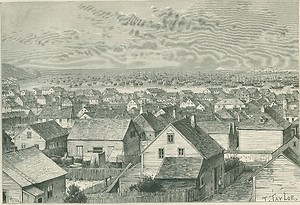 A brief history of Saint-Pierre and Miquelon
A brief history of Saint-Pierre and Miquelon
For centuries, the history of Saint-Pierre and Miquelon and New France were closely linked, but by the second half of the 18th century, Saint-Pierre and Miquelon had become the lone French territory in North America. Its destiny, initially tied to the volatile relations between Britain and France, ultimately became a close reflection of France’s own struggles with absolutism, revolution, colonialism and war.
1. Exploration and discovery
 Saint-Pierre and Miquelon’s privileged geographical position along the southern coast of Newfoundland gave the islands a particular importance in the early cartography of Newfoundland; the Barbatos of Johannes Ruysch’s map of 1506, the Ile Verte of the Corte Real expeditions, the Illa de la Trenidat of the Juan de la Cosa map of 1500 are all likely representations of the Saint-Pierre and Miquelon group of islands.
Saint-Pierre and Miquelon’s privileged geographical position along the southern coast of Newfoundland gave the islands a particular importance in the early cartography of Newfoundland; the Barbatos of Johannes Ruysch’s map of 1506, the Ile Verte of the Corte Real expeditions, the Illa de la Trenidat of the Juan de la Cosa map of 1500 are all likely representations of the Saint-Pierre and Miquelon group of islands.
Beyond the cartographic record, it was in 1536 that the first written reference to the name Saint-Pierre was made by Jacques Cartier. Clearly not a discovery, Cartier’s reference to the “said islands of sainct Pierre” was more a summary reference to a well-known territorial beacon. In actuality, Jacques Cartier was not the first explorer to make note of his passage in Saint-Pierre and Miquelon.
Some fifteen years earlier, Joao Alvarez Faguendes, an explorer from King Manuel’s Portugal baptised the Archipelago in honour of Saint Ursula, who according to Christian legend was the saviour of Eleven Thousand Virgins. The Onze Myll Virgines Archipelago or Virgines Islands were present on many maps as late as 1593; however, the Portuguese influence was short lived and the name became extinct. As the Lusitanian presence in Newfoundland waxed and waned, geographers of other European countries made episodic mention of Saint-Pierre, Miquelon and the adjoining islands. For instance, in 1541, the Spanish geographer, Alonzo de Santa Cruz described the islands of Eleven Thousands Virgins as being frequented by Breton and Irish fishermen.
Three years later, the French geographer Jean Alphonse described the islands of Saint-Pierre in his Islario and in 1579; the first mention of the island of Miquelon was made in Martin de Hoyarçabal’s navigational pilot.
2. Saint-Pierre and Miquelon, French fishing establishment
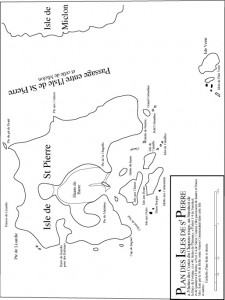 Archival references aside, by the end of the 18th century, Saint-Pierre had become a seasonal settlement for fishermen from Saint-Malo and Granville. The Basques of Saint-Jean de Luz used Miquelon and Lizardie cove in Saint-Pierre.
Archival references aside, by the end of the 18th century, Saint-Pierre had become a seasonal settlement for fishermen from Saint-Malo and Granville. The Basques of Saint-Jean de Luz used Miquelon and Lizardie cove in Saint-Pierre.
In Saint-Pierre, harbour tensions often arose between local inhabitants and the seasonal captains from France over trade issues and access to the vital shoreline and graves for drying and curing of fish. By the 1690’s, Saint-Pierre had become a bustling community with many fishing stations and close to 200 workers. Then again, skirmishes with the British left Saint-Pierre unprotected and vulnerable. This situation, compounded with the staunch refusal of those established in Saint-Pierre to follow any orders from the Governor of Placentia, made the defence of the islands a difficult task at the least.
3. Franco-British Rivalries
 Constant battles between the French and the English around the coast of Newfoundland in the following years made any use of Saint-Pierre as a fishing ground a risky enterprise at the best of times; no fewer than five British raids occurred between 1691 and 1708.
Constant battles between the French and the English around the coast of Newfoundland in the following years made any use of Saint-Pierre as a fishing ground a risky enterprise at the best of times; no fewer than five British raids occurred between 1691 and 1708.
Nevertheless, by 1713, the treaty of Utrecht had sealed the fate of the French possessions in Newfoundland, and most of the French inhabitants of Placentia and the surrounding communities were encouraged to migrate towards Louisbourg in the new colony of l’Isle Royale (Cape Breton).
Despite official despatches to France, several French citizens who swore allegiance to Britain remained on the Southern Shores of Newfoundland and in Saint-Pierre as noted by Captain William Taverner. It was under these circumstances that the “Island of Saint Peter”, became a fishing establishment of British Newfoundland for the next fifty years.
4. The end of the French North American Empire
In 1755, in neighbouring Nova Scotia, the Acadian population became the unwilling participants of a deportation campaign designed to rid the British colony of Nova Scotia of its French inhabitants. Some Acadians escaped to Louisbourg, others made it to Quebec, and France.
5. The treaty of Paris, 1763
 It was the Treaty of Paris, in 1763, following the Seven Year War, which established the islands of Saint-Pierre and Miquelon as a shelter for the French fishery; the French soon took advantage of this establishment and the King took all necessary steps to ensure that the colony was a successful enterprise but before long the arrival of Acadian refugees, Louisbourg Merchants, and the fast growth of the new colony raised serious issues. On top of this, relations with the British government in Newfoundland quickly became difficult. Hugh Palliser saw any French military presence in Saint-Pierre as a serious threat, just as William Pitt the Elder in London feared the islands would become a second Louisburg.
It was the Treaty of Paris, in 1763, following the Seven Year War, which established the islands of Saint-Pierre and Miquelon as a shelter for the French fishery; the French soon took advantage of this establishment and the King took all necessary steps to ensure that the colony was a successful enterprise but before long the arrival of Acadian refugees, Louisbourg Merchants, and the fast growth of the new colony raised serious issues. On top of this, relations with the British government in Newfoundland quickly became difficult. Hugh Palliser saw any French military presence in Saint-Pierre as a serious threat, just as William Pitt the Elder in London feared the islands would become a second Louisburg.
Thus relations between the French and the British remained tense. Moreover, events in the American colonies would soon prove disastrous for Saint-Pierre and Miquelon. An active trade had developed between the French and the Americans in Saint-Pierre, which the British in Newfoundland and Nova Scotia had tolerated to some degree.
6. French support for the American war of Independence, consequences for Saint-Pierre and Miquelon
But French support for the American war of Independence meant only one thing in the end: on September 13th 1778, five British war ships sailed into Saint-Pierre’s harbour under Commodore Evans. The Baron of l’Espérance, unable to defend his island, capitulated. Saint-Pierre and Miquelon was evacuated and the inhabitants were deported and dispersed, only to live in poverty in the many harbours of western France, while the British ensured that the establishments in Saint-Pierre were completely destroyed.
7. The treaty of Versailles, 1783
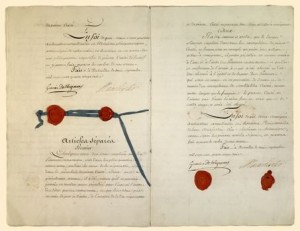 Nevertheless, when the treaty of Versailles of 1783 established the return of Saint-Pierre and Miquelon to France, establishments were rebuilt and the population returned to the islands. The baron of l’Espérance had grand plans for the fortification of the islands and the building of a large settlement; however, French policy was more fiscally conservative.
Nevertheless, when the treaty of Versailles of 1783 established the return of Saint-Pierre and Miquelon to France, establishments were rebuilt and the population returned to the islands. The baron of l’Espérance had grand plans for the fortification of the islands and the building of a large settlement; however, French policy was more fiscally conservative.
The kingdom of France had declared bankruptcy some years earlier and after bankrolling the American Revolution, the coffers were empty, and no monies would be available for fortifications. All such plans were abandoned and the islands were to remain a fishing outport. By 1788, the economic situation in France had become so desperate that the Estates General had been called for the first time since 1615 to examine the King’s request to raise new taxes. France was on the verge of revolution.
8. The last British Expedition against Saint-Pierre & Miquelon
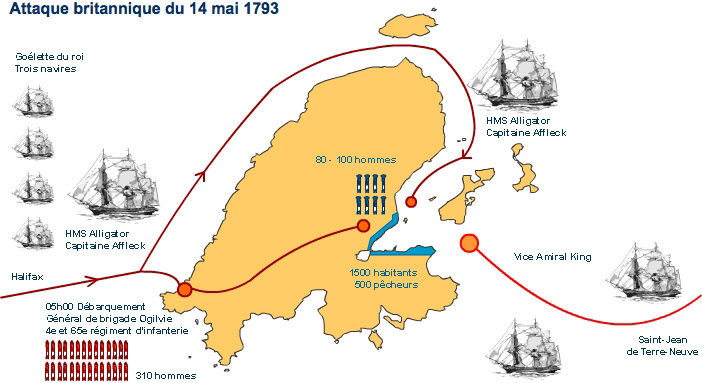 The traditional Acadian population of Miquelon, being staunchly loyal to its Catholic faith and to the throne of France, fled the colony for the Magdalen islands. By May 5th 1793, news of War between Britain and France reached Saint-Pierre. Nine days later, at six o’clock in the morning, the 300 British troops, three frigates and four other ships of Rear-Admiral King and Brigadier General Ogilvie marked the end of North America’s smallest republican experiment. Over the next year, the 1500 inhabitants of Saint-Pierre and Miquelon who hadn’t managed to flee were held prisoner by 160 British troops. During the fall of 1794, the remaining population was shipped to Halifax and held until 1796. The British used the settlements of Saint-Pierre for their own fishery, but could not survive the retaliatory campaign of French Admiral Richerie, who sank over 80 British fishing vessels and destroyed the establishments of Saint-Pierre after failing in an attack on Saint John’s.
The traditional Acadian population of Miquelon, being staunchly loyal to its Catholic faith and to the throne of France, fled the colony for the Magdalen islands. By May 5th 1793, news of War between Britain and France reached Saint-Pierre. Nine days later, at six o’clock in the morning, the 300 British troops, three frigates and four other ships of Rear-Admiral King and Brigadier General Ogilvie marked the end of North America’s smallest republican experiment. Over the next year, the 1500 inhabitants of Saint-Pierre and Miquelon who hadn’t managed to flee were held prisoner by 160 British troops. During the fall of 1794, the remaining population was shipped to Halifax and held until 1796. The British used the settlements of Saint-Pierre for their own fishery, but could not survive the retaliatory campaign of French Admiral Richerie, who sank over 80 British fishing vessels and destroyed the establishments of Saint-Pierre after failing in an attack on Saint John’s.
9. Life in Exile and the Second Treaty of Paris
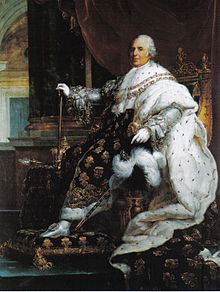 During the following years, the monumental upheavals in France, including Napoleon’s accession and domination of Europe were to keep the islands of Saint-Pierre and Miquelon out of French hands except for one brief moment in 1802-1803. Although the Amiens treaty of 1802 had decreed that Saint-Pierre and Miquelon would once again be returned to France, the state of the colony, the strained relations between France and Britain, and the Napoleonic Empire kept the islands out of French hands until the second abdication of the Emperor in 1815. It was therefore the second treaty of Paris, in 1815, which formalized the final restitution of Saint-Pierre and Miquelon to the kingdom of France and by 1816 the first inhabitants had returned to the islands.
During the following years, the monumental upheavals in France, including Napoleon’s accession and domination of Europe were to keep the islands of Saint-Pierre and Miquelon out of French hands except for one brief moment in 1802-1803. Although the Amiens treaty of 1802 had decreed that Saint-Pierre and Miquelon would once again be returned to France, the state of the colony, the strained relations between France and Britain, and the Napoleonic Empire kept the islands out of French hands until the second abdication of the Emperor in 1815. It was therefore the second treaty of Paris, in 1815, which formalized the final restitution of Saint-Pierre and Miquelon to the kingdom of France and by 1816 the first inhabitants had returned to the islands.
10. A new century
Consequently, following a century of warfare between Britain and France, deportations, poverty and political upheaval, the exiles of Saint-Pierre and Miquelon would no longer be the pawns of Empires. By the end of the 19th century the population would expand eight fold and Saint-Pierre would become one of France’s most important harbours.
 The seasonal French Fishery expanded quickly. As well, important commercial links were established with Spain for salt, the United States and France for supplies such as lumber, fishing equipment and food staples. Hundreds of seasonal workers were brought over to cure, dry and salt fish. Hundreds more worked on the fishing Banks. Despite three major fires and many losses at sea, the town of Saint-Pierre kept expanding towards the hills, and the Island of Dogs (Ile aux Chiens) across the harbour soon became a town of its own.
The seasonal French Fishery expanded quickly. As well, important commercial links were established with Spain for salt, the United States and France for supplies such as lumber, fishing equipment and food staples. Hundreds of seasonal workers were brought over to cure, dry and salt fish. Hundreds more worked on the fishing Banks. Despite three major fires and many losses at sea, the town of Saint-Pierre kept expanding towards the hills, and the Island of Dogs (Ile aux Chiens) across the harbour soon became a town of its own.
This growing importance of Saint-Pierre and the expansion of the French Fishery before long raised the ire of merchants and politicians of Saint John’s, who realized that the islands’ influence on the Southern Shore of Newfoundland and the French Shore was strengthening. New treaties between France and Britain over the French Shore in 1857 caused significant unrest, fanning anti-French sentiment in Newfoundland politics. For example by 1887, the Bait Bill came into play, prohibiting the sale of bait to French fishermen. This measure in fact was more damaging to the economy and commerce of the Southern Shore of Newfoundland itself. It symbolized, of course, the rising tensions between Saint John’s and Saint-Pierre.
11. Crisis in the fishery
In 1901-1902, Saint-Pierre’s population expanded to about 6500 inhabitants and its fishery employed over 4000 seasonal workers, but a number of events were about to shake the foundation of Saint-Pierre’s economy. Starting in 1892, France imposed custom tariffs that made purchasing any materials from Canada, Newfoundland or the USA cost prohibitive. The local fishing industry had to import everything from France at grossly inflated prices; this situation lasted until 1912, long enough to be a factor in a serious economic downturn. By the early 1900s, the worst fishing campaigns in decades, combined with tragic losses at sea and the modernisation, mechanisation and growing independence of the French fishing fleet all contributed to the rapid reduction of the local fleet and the departure of over 2000 inhabitants to France and Canada. By 1904, another symbolic blow came into being, as France abandoned the French Shore in exchange for territorial gains in its African colonies. This was the price of the Entente Cordiale.
12. World War I
 In 1914, war broke out in Europe and by 1915 several hundred men from Saint-Pierre, Ile aux Chiens and Miquelon left the North Atlantic for the Colonial Battalions and the killing fields of France. Close to a hundred soldiers lost their lives in Europe and many of those who returned to Saint-Pierre and Miquelon after 1919 had serious emotional and physical scars, some caused by chemical warfare.
In 1914, war broke out in Europe and by 1915 several hundred men from Saint-Pierre, Ile aux Chiens and Miquelon left the North Atlantic for the Colonial Battalions and the killing fields of France. Close to a hundred soldiers lost their lives in Europe and many of those who returned to Saint-Pierre and Miquelon after 1919 had serious emotional and physical scars, some caused by chemical warfare.
13. Prohibition
With the decline of the fishery, and the economic consequences of the war, Saint-Pierre and Miquelon seemed destined to fade into economic collapse. At this point, the legislative achievements of an American Senator, Andrew Volstead, unwittingly put the islands back on the tracks to prosperity.
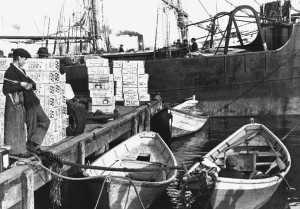 This new era in the economic history of the islands came about as follows: on October 28th 1919, the United States of America became a “dry country” under the National Prohibition Act. In a peculiar turn of events, American rumrunners turned their attention to Saint-Pierre and Miquelon, and before long the islands had become North America’s alcohol warehouse. Powerful syndicates used the islands as a strategic base for rum running along the Eastern Seaboard of Nova Scotia and New England. The taxation system in Saint-Pierre and Miquelon, along with the general activity surrounding the importing and exporting of spirits, provided employment and revenue for all.
This new era in the economic history of the islands came about as follows: on October 28th 1919, the United States of America became a “dry country” under the National Prohibition Act. In a peculiar turn of events, American rumrunners turned their attention to Saint-Pierre and Miquelon, and before long the islands had become North America’s alcohol warehouse. Powerful syndicates used the islands as a strategic base for rum running along the Eastern Seaboard of Nova Scotia and New England. The taxation system in Saint-Pierre and Miquelon, along with the general activity surrounding the importing and exporting of spirits, provided employment and revenue for all.
14. More economic hardship
Yet, as quickly as Prohibition came, it went. Prohibition was revoked with the 21st amendment to the American Constitution in 1933. Under pressure from the United States, France outlawed illegal alcohol trade activity on the islands in 1935. The islanders swiftly came to the brutal realisation that the local economy would once again be in tatters. The workforce had lost interest in the difficult labour of the sea. The fishery had been all but abandoned. Immigration towards Canada temporarily resumed as entire families left their depressed islands. In 1937, an autocratic, conservative, yet dedicated governor was appointed. Gilbert de Bournat undertook work for welfare schemes, commissioned geological studies, and established measures to strengthen the social safety net in Saint-Pierre and Miquelon.
15. World War II, Vichy and the Free French
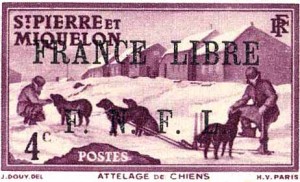 On a larger front, 1940 brought the complete collapse of the French under attack from Germany. French President Albert Lebrun gave the political levers of power to Marshall Philippe Pétain. Pétain signed an armistice with Hitler, thrusting Saint-Pierre and Miquelon, along with the rest of France’s colonial empire into the hands of Vichy France. As such, the islands became an object of political and strategic concern for Newfoundland, Canada, the United States and the Free French Forces of Charles de Gaulle.
On a larger front, 1940 brought the complete collapse of the French under attack from Germany. French President Albert Lebrun gave the political levers of power to Marshall Philippe Pétain. Pétain signed an armistice with Hitler, thrusting Saint-Pierre and Miquelon, along with the rest of France’s colonial empire into the hands of Vichy France. As such, the islands became an object of political and strategic concern for Newfoundland, Canada, the United States and the Free French Forces of Charles de Gaulle.
Resenting the autocratic and overtly Pétainist overtones of Count de Bournat’s administration, large segments of the local population organised a pro-Gaullist movement advocating joining the Free French Forces. Aided somewhat by the Monroe Doctrine but chiefly by the American recognition of the Vichy Government, Count de Bournat was able to negotiate an economic assistance package for the Saint-Pierre and Miquelon economy based on the frozen assets of the French government. The French Fishing Fleet returned to France after De Bournat obtained the removal of the naval blockade by Ottawa and Washington.
On December 24th 1941, following strict orders from Charles de Gaulle, and feigning naval exercises, Rear Admiral Émile Muselier headed for Saint-Pierre’s harbour with three corvettes and the submarine Surcouf. Within minutes, Gilbert de Bournat had surrendered his authority to Muselier and the islands became part of Free France. The liberation of Saint-Pierre and Miquelon exploded into a bona fide international incident as Washington refused to condone the Free French actions and considered any political change in Saint-Pierre as contrary to the Monroe Doctrine. Despite military threats from the American administration, public opinion and a handful of American and Canadian journalists, forced Secretary of State Cordell Hull to abandon any interest in the matter. The story of Saint-Pierre and Miquelon’s liberation by the Free French went from gracing the front page of the New York Times to complete obscurity as the violence of World War II raged on.
16. The post war era, boundary issues with Canada
 Moving forward to the 1950s and 1960s, the local fishing industry employed a great number of locals as the fleet became more mechanised. Codfish remained the essential resource for the islands. However by 1977, a serious territorial dispute arose between France and Canada as both countries extended their territorial rights to 200 miles offshore.
Moving forward to the 1950s and 1960s, the local fishing industry employed a great number of locals as the fleet became more mechanised. Codfish remained the essential resource for the islands. However by 1977, a serious territorial dispute arose between France and Canada as both countries extended their territorial rights to 200 miles offshore.
The fact that Newfoundland and Saint-Pierre are only separated by a twelve-mile stretch of water created a political conundrum as both states claimed overlapping territorial rights. This issue would become the focal point of local and regional politics for the next two decades.
In 1981, the government of France requested an international arbitration over the territorial and fishing rights of both countries. In 1986 Ottawa proposed an ad hoc international tribunal determining sole territorial rights. France rejected the offer and tensions flared between Newfoundland and Saint-Pierre. In 1988 Canada went so far as to close its harbours to French vessels, and accused them of over fishing the resources.
When fishing quotas were drastically cut, the local population and its politicians organised a number of spectacular political protests including the « illegal » fishing campaign of 1988 which culminated with the arrest of the entire crew of the Croix de Lorraine, which included most of Saint-Pierre and Miquelon’s politicians. Despite protests and large fines, there was no end result.
The ad hoc International Tribunal in New York was left to determine the boundary between France and Canada. The Tribunal set forth its final decision in June of 1992 by granting Saint-Pierre and Miquelon a small economic zone upon which was pinned a 100-mile long, 10-mile wide corridor to international waters.
This decision stunned observers from both countries, but Canada believed it had benefited the most. The settlement of the boundary issue between France and Canada has opened the door to future oil exploration but the fundamentals of Saint-Pierre and Miquelon’s economy has yet again been changed dramatically.

Correction in 1755 the French were exiled from Nova Scotia including Louisburg, they were scattered everywhere, Many were displaced to Louisiana and other parts of the United States. Many escaped to St. Pierre & Miquelon, Quebec and other areas but I believe they exiled from Louisbourg also
Bonjour
heureux de vous rejoindre.
Je ne sais pas si je poste au bon endroit, je n’ai pas l’habitude des forums.
Je suis plutôt habitué à simplement lire sans participer.
Mais certains sujets m’ont tellement motivé et apporté que j’ai décidé de m’inscrire.